Repulsion Study guides, Class notes & Summaries
Looking for the best study guides, study notes and summaries about Repulsion? On this page you'll find 567 study documents about Repulsion.
All 567 results
Sort by
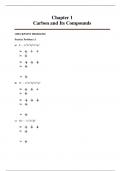 Popular
Popular
-
Solution Manual for Organic Chemistry Mechanistic Patterns Canadian 1st Edition Ogilvie Ackroyd Br
- Exam (elaborations) • 809 pages • 2024
-
- $48.48
- 1x sold
- + learn more
Chapter 1 Carbon and Its Compounds CHECKPOINT PROBLEMS Practice Problem 1.1 a) S — 1s2 2s2 2p6 3s2 3p4 b) Cl — 1s2 2s2 2p6 3s2 3p5 c) Na+ — 1s2 2s2 2p6 1-2 Copyright © 2018 Nelson Education Limited Practice Problem 1.2 a) Count valence electrons. Build a basic bonding framework and account for electrons used. Add remaining electrons and check for formal charges. The molecule has a lone pair on the nitrogen. All other electrons are bonding electrons. b) Count valence...
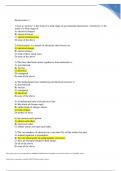 Popular
Popular
-
PHYS 1260 Exam 1 DeWitt questions and answers graded A+
- Exam (elaborations) • 6 pages • 2024 Popular
-
- $14.49
- 1x sold
- + learn more
Electrostatics 1 1) Just as "gravity" is the study of a wide range of gravitational interactions, "electricity" is the study of a wide range of A) electrical charges. B) electrical forces. C) electrical interactions. D) none of the above 2) Electrostatics is a branch of electricity that focuses on A) electrical charge. B) electrical force. C) both of these when static. D) none of the above 3) The force that binds atoms together to form molecules is A) gravitational. B) nuclear....
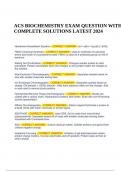
-
ACS BIOCHEMISTRY EXAM QUESTION WITH COMPLETE SOLUTIONS LATEST 2024.
- Exam (elaborations) • 19 pages • 2024
-
- $12.99
- 1x sold
- + learn more
ACS BIOCHEMISTRY EXAM QUESTION WITH COMPLETE SOLUTIONS LATEST 2024. Henderson-Hasselbach Equation - CORRECT ANSWER - pH = pKa + log ([A-] / [HA]) FMOC Chemical Synthesis - CORRECT ANSWER - Used in synthesis of a growing amino acid chain to a polystyrene bead. FMOC is used as a protecting group on the Nterminus. Salting Out (Purification) - CORRECT ANSWER - Changes soluble protein to solid precipitate. Protein precipitates when the charges on the protein match the charges in the solution. ...
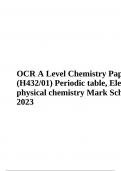
-
OCR A Level Chemistry Paper 1 (H432/01) Periodic table, Elements and physical chemistry Mark Scheme June 2023
- Exam (elaborations) • 35 pages • 2024
-
- $14.99
- 1x sold
- + learn more
OCR A Level Chemistry Paper 1 (H432/01) Periodic table, Elements and physical chemistry Mark Scheme June 2023. FIRST CHECK THE ANSWER ON ANSWER LINE If answer = –1872 award 2 marks ----------------------------------------------------------------- H lattice = 2(+ 296) – 965 – 503 – 180 + 2(–107)– 602 H lattice = –1872 (kJ mol–1 ) 2 AO2.2 2 ALLOW for 1 mark +1872 (wrong sign on answer) Common errors for 1 mark –3056 (–296 x 2 instead of 296 x2) –2168 (2...
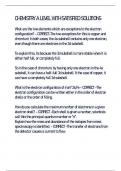
-
AQA CHEMISTRY A LEVEL WITH COMPLETE SOLUTIONS covalent bond - ANSWER-a shared pair of electrons between non-metal elements co-ordinate bond - ANSWER-a shared pair of electrons where both electrons are supplied by one atom repulsion in shapes of molecu
- Exam (elaborations) • 70 pages • 2024
-
- $20.49
- + learn more
AQA CHEMISTRY A LEVEL WITH COMPLETE SOLUTIONS covalent bond - ANSWER-a shared pair of electrons between non-metal elements co-ordinate bond - ANSWER-a shared pair of electrons where both electrons are supplied by one atom repulsion in shapes of molecules - ANSWER-Lone pair-lone pair > lone pair-bonding pair > bonding pair-bonding pair electronegativity - ANSWER-the power of an atom to attract the pair of electrons in a covalent bond hess' law - ANSWER-Total enthalpy chang...
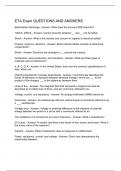
-
ETA Exam QUESTIONS AND ANSWERS
- Exam (elaborations) • 4 pages • 2023
- Available in package deal
-
- $10.49
- 1x sold
- + learn more
Electrostatic Discharge - Answer- What does the acronym ESD stand for? 100mA, 200mA - Answer- Current amounts between __ and __ can be lethal. Shock - Answer- What is the number one concern in regards to electrical safety? Protons, neutrons, electrons - Answer- Bohr's Atomic Model consists of what three components? Shells - Answer- Electrons are arranged in __ around the nucleus. Conductors, semi-conductors, and insulators - Answer- What are three types of materials used in elect...
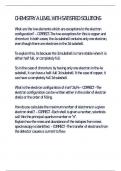
-
AQA CHEMISTRY A LEVEL WITH COMPLETE SOLUTIONS covalent bond - ANSWER-a shared pair of electrons between non-metal elements co-ordinate bond - ANSWER-a shared pair of electrons where both electrons are supplied by one atom repulsion in shapes of molecu
- Exam (elaborations) • 70 pages • 2024
-
- $19.49
- + learn more
AQA CHEMISTRY A LEVEL WITH COMPLETE SOLUTIONS covalent bond - ANSWER-a shared pair of electrons between non-metal elements co-ordinate bond - ANSWER-a shared pair of electrons where both electrons are supplied by one atom repulsion in shapes of molecules - ANSWER-Lone pair-lone pair > lone pair-bonding pair > bonding pair-bonding pair electronegativity - ANSWER-the power of an atom to attract the pair of electrons in a covalent bond hess' law - ANSWER-Total enthalpy chang...
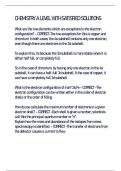
-
AQA CHEMISTRY A LEVEL WITH COMPLETE SOLUTIONS covalent bond - ANSWER-a shared pair of electrons between non-metal elements co-ordinate bond - ANSWER-a shared pair of electrons where both electrons are supplied by one atom repulsion in shapes of molecu
- Exam (elaborations) • 70 pages • 2024
-
- $19.99
- + learn more
AQA CHEMISTRY A LEVEL WITH COMPLETE SOLUTIONS covalent bond - ANSWER-a shared pair of electrons between non-metal elements co-ordinate bond - ANSWER-a shared pair of electrons where both electrons are supplied by one atom repulsion in shapes of molecules - ANSWER-Lone pair-lone pair > lone pair-bonding pair > bonding pair-bonding pair electronegativity - ANSWER-the power of an atom to attract the pair of electrons in a covalent bond hess' law - ANSWER-Total enthalpy chang...

-
AQA A level design and technology Magnetism ANSWERThe force of attraction or repulsion of magnetic materials electrical conductor ANSWERA material through which electric charge can flow easily electrical insulator ANSWERa material through which charge can
- Exam (elaborations) • 45 pages • 2024
-
- $13.99
- + learn more
AQA A level design and technology Magnetism ANSWERThe force of attraction or repulsion of magnetic materials electrical conductor ANSWERA material through which electric charge can flow easily electrical insulator ANSWERa material through which charge cannot flow easily thermal conductor ANSWERa material through which thermal energy flows easily thermal insulator ANSWERa material through which
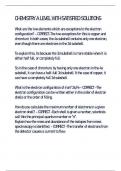
-
AQA CHEMISTRY A LEVEL WITH COMPLETE SOLUTIONS covalent bond - ANSWER-a shared pair of electrons between non-metal elements co-ordinate bond - ANSWER-a shared pair of electrons where both electrons are supplied by one atom repulsion in shapes of molecu
- Exam (elaborations) • 70 pages • 2024
-
- $20.49
- + learn more
AQA CHEMISTRY A LEVEL WITH COMPLETE SOLUTIONS covalent bond - ANSWER-a shared pair of electrons between non-metal elements co-ordinate bond - ANSWER-a shared pair of electrons where both electrons are supplied by one atom repulsion in shapes of molecules - ANSWER-Lone pair-lone pair > lone pair-bonding pair > bonding pair-bonding pair electronegativity - ANSWER-the power of an atom to attract the pair of electrons in a covalent bond hess' law - ANSWER-Total enthalpy chang...
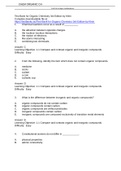
-
Test Bank for Organic Chemistry 3rd Edition by Klein
- Exam (elaborations) • 76 pages • 2022
-
- $13.99
- 1x sold
- + learn more
Test Bank for Organic Chemistry 3rd Edition by KleinChemical reactions occur as a result of __________ A. the attraction between opposite charges. B. the nucleus–nucleus interactions. C. the motion of electrons. D. like atoms interacting. E. combining two chemicals.Chemical reactions occur as a result of __________ A. the attraction between opposite charges. B. the nucleus–nucleus interactions. C. the motion of electrons. D. like atoms interacting. E. combining two chemicalsWhat is the diffe...

How much did you already spend on Stuvia? Imagine there are plenty more of you out there paying for study notes, but this time YOU are the seller. Ka-ching! Discover all about earning on Stuvia


